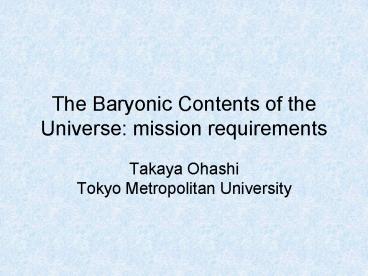The Baryonic Contents of the Universe: mission requirements - PowerPoint PPT Presentation
1 / 16
Title:
The Baryonic Contents of the Universe: mission requirements
Description:
Identification of the major form of baryons in the present ... Direct view of the 3-dimensional structure ... Cosmic web: Millenium simulation. z=0. z=1.4 ... – PowerPoint PPT presentation
Number of Views:48
Avg rating:3.0/5.0
Title: The Baryonic Contents of the Universe: mission requirements
1
The Baryonic Contents of the Universe mission
requirements
- Takaya OhashiTokyo Metropolitan University
2
Science of the baryon survey
- WHIM warm-hot intergalactic medium
- Identification of the major form of baryons in
the present universe dark baryon or missing
baryon problem - Direct view of the 3-dimensional structure of the
universe - Evolution of the hot phase of the universe
different view of the evolution against collapsed
cold-phase objects (stars, galaxies) - Metal enrichment history
Dark Matter
Baryons 4
Dark Energy
Dark baryon (60-80)
Hot gas
Stars, Galaxies
3
WHIM major form of baryons
- Half of the baryons at z0 are in the form of
WHIM - 71 of metals in the universe are contained in
WHIM - Median metallicity of Oxygen is 0.18 solar in WHIM
Cen and Ostriker astro-ph/0601008
4
Cosmic web Millenium simulation
125 Mpc/h
z0
z1.4
z5.7
Virgo consortium http//www.virgo.dur.ac.uk/
- WHIM is the major baryonic form after z 0.5
- Necessary survey area to see structures 100200
Mpc - 100 Mpc corresponds to 28.8? (z0.05),
15.2?(z0.1), 6.3? (z0.3) - Therefore, the survey area should be at least
10? about 100 pointings with 1? field of view
5
Tracer of LSS
Galaxies (104K)
Darkmatter
WHIM (105-107 K) is the best tool to trace the
cosmic large-scale structure
Yoshikawa et al. 2001, ApJ, 558, 520
size 30 h-1 Mpc
Cluster gas (107K)
IGM (105K)
6
Thermal history of the universe
WHIM will tell us the evolution of the hot-phase
material in the universe
7
Scientific requirements concerning the WHIM survey
- Clear detection of missing baryons separation
from the Galactic oxygen lines which are 100
times more intense DE, S, W - Observation of the cosmic web structure in a
reasonable mission time (lt 3 yrs) DE, S, W, sun
angle constraint - Detection of helium like oxygen triplet lines
temperature and abundance of the cloud are
constrained DE, S, W - Bulk motion or turbulence of the filament 1000
km s-1 DE, S, W
8
OVII OVIII Emission Lines
- High resolution and high sensitivity (SW and DE)
observations will detect WHIM oxygen emission
lines - Intensity ratios of the lines can tell us the
temperature and ionization condition
9
Simulated OVII OVIII lines
1000 photons
100 photons
With gt 100 (nearly 1000) photons, we can utilize
triplet line from oxygen ? unambiguous line
identification ? determination of redshift and
temperature
10
He-like Oxygen K line
DE2eV
DE1eV
DE5eV
DE10eV
DE lt 5 eV is necessary to resolve line
components which enables us temperature
determination unambiguously
11
He-like Iron K lines
DE2eV
DE1eV
DE5eV
DE10eV
DE 10 eV can still resolve line components
12
Spectrum of a 3 keV plasma
DE lt 5 eV seems necessary for clear line
separation
13
Detectable photons
Yoshikawa et al. (2003) Pub.Astron.Soc.Japan 55
879
0.88 deg2 texp300 ks
- DIOS spec is assumed area 110 cm2
- Number of detected line photons typically 200
cts/line - Factor of several better statistics (? 1000
cts/line) is desirable - With 500 cm2 area, 1000 counts are obtained in
300 ksec (4-5 days)
14
Fraction of baryons detectable via oxygen emission
OVII
OVIII
DIOS detection limit (Texp105s S/N10)
DIOS detection limit (Texp105s S/N10)
15
Observable sky
13x 13 accessible 1 yr
1 year
10x 10100 day x 2
7x 750 day x 2
Allowed sun angle 90 deg 25 deg (DIOS)
FOV direction perpendicular to the sun enables us
very deep exposure of the pole regions
16
Summary of mission requirements
- Energy resolution lt 5 eV is necessary to
separate oxygen line triplets. Goal is 2 eV. - Area gt100 cm2 to survey 10? x 10? sky in 1-2
yrs. 500 cm2 as the goal is reasonable. - Field of view should be close to 1? to observe
the large-scale structure. This should be kept as
the basic requirement. - Sun angle constraint preferable to have the
field direction perpendicular to the sun
direction, but not absolute. - Life at least 3 yrs, goal is 5 yrs or more
- Imaging instrument desirable to have a
wide-field fine imaging detector on board.
Otherwise, we observe the XMM or Chandra survey
fields. This is necessary to know contaminating
oxygen sources (starbursts, AGN, groups, )































